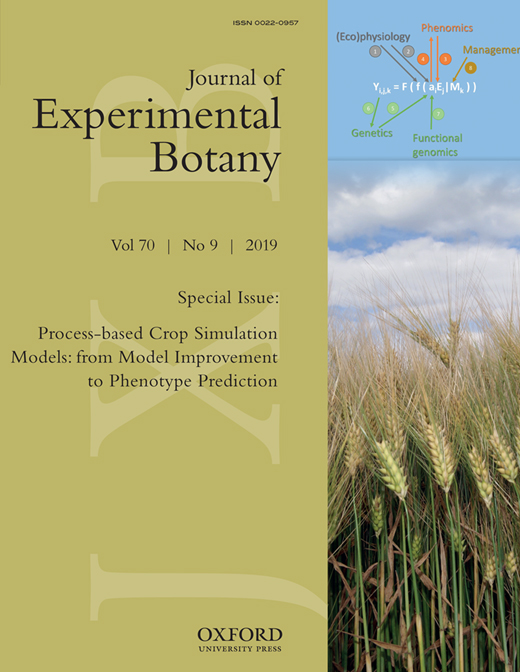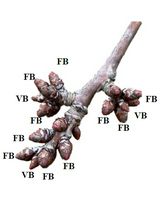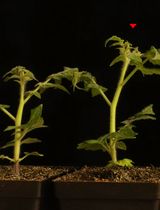- EN - English
- CN - 中文
Experiments for in silico evaluation of Optimality of Photosynthetic Nitrogen Distribution and Partitioning in the Canopy: an Example Using Greenhouse Cucumber Plants
树冠中光合氮分配的最适生物信息学评估实验:温室黄瓜应用实例
发布: 2020年03月20日第10卷第6期 DOI: 10.21769/BioProtoc.3556 浏览次数: 5988
评审: Samik BhattacharyaYing FengPablo Bolanos-Villegas
Abstract
Acclimation of leaf traits to fluctuating environments is a key mechanism to maximize fitness. One of the most important strategies in acclimation to changing light is to maintain efficient utilization of nitrogen in the photosynthetic apparatus by continuous modifications of between-leaf distribution along the canopy depth and within-leaf partitioning between photosynthetic functions according to local light availability. Between-leaf nitrogen distribution has been intensively studied over the last three decades, where proportional coordination between nitrogen concentration and light gradient was considered optimal in terms of maximizing canopy photosynthesis, without taking other canopy structural and physiological factors into account. We proposed a mechanistic model of protein turnover dynamics in different photosynthetic functions, which can be parameterized using leaves grown under different levels of constant light. By integrating this dynamic model into a multi-layer canopy model, constructed using data collected from a greenhouse experiment, it allowed us to test in silico the degree of optimality in photosynthetic nitrogen use for maximizing canopy carbon assimilation under given light environments.
Background
Intra-canopy nitrogen distribution in response to light has been intensively studied (Hirose and Werger, 1987; Werger and Hirose, 1991; Anten et al., 1995; Dreccer et al., 2000; Moreau et al., 2012; Hikosaka, 2016) and many studies demonstrated that, although the actual nitrogen distribution resulted in higher canopy photosynthesis than uniform nitrogen distribution, it was still suboptimal (Field, 1983; Evans, 1993; Hollinger, 1996; Hirose et al., 1997; Meir et al., 2002; Wright et al., 2006; Hikosaka, 2016). This discrepancy between optimum and reality could, on one hand, be explained by physiological limitations (Niinemets, 2012; Hikosaka, 2016). On the other hand, it might result from incorrect predictions by over-simplified models, where the effects of variations in the structural characteristics on light interception, age-dependent modifications of leaf biochemistry and photoacclimation in functional nitrogen partitioning were neglected. To incorporate these factors into the acclimation processes, a mechanistic model based on the concept of protein turnover (synthesis and degradation) was proposed to simulate the dynamics of photosynthetic nitrogen in carboxylation, electron transport and light harvesting functions along the development and ageing of the leaf (Pao et al., 2019a and 2019b). Leaf elevation angle and leaf area distribution in the canopy was measured to construct a multi-layer canopy model for simulating more realistic intra-canopy light distribution, which is used as input for the protein turnover model. By manipulating the parameters controlling nitrogen distribution and partitioning, it is possible to quantify the degree of optimality in photosynthetic nitrogen use for maximizing canopy carbon assimilation in silico.
Materials and Reagents
- 25-L plastic boxes, as container for hydroponic system
- Polystyrene foam boards for fixing plants onto plastic boxes
- Rockwool cubes (10 cm × 10 cm × 6.5 cm), as growth medium in the hydroponic system (Grodan Delta; Grodan, Roermond, The Netherlands)
- Rockwool cubes (3.6 cm × 3.6 cm × 4 cm), as seed sowing medium (Grodan A-OK Starter Plugs; Grodan, Roermond, The Netherlands)
- Plastic plant support clips
- N-P-K fertilizer (Ferty 2 MEGA; Planta, Regenstauf, Germany)
- P-K fertilizer (Ferty Basisdünger 1; Planta, Regenstauf, Germany)
- N fertilizer (YaraLiva Calcinit; Yara, Oslo, Norway)
- Paper bags (size should be enough to contain a single cucumber lamina, which is about 15 cm × 20 cm or larger)
- Rockwool slabs (100 cm × 20 cm × 7.5 cm), as growth medium in the greenhouse (Grodan GT Expert; Grodan, Roermond, The Netherlands)
- Seed (Cucumis sativus ‘Aramon’, Rijk Zwaan, De Lier, The Netherlands)
- 1% H2SO4 (96% H2SO4, Carl Roth, catalog number: 4623 ; preparation: 6 ml 96% H2SO4 mix with 1 L H2O)
Equipment
- Walk-in growth chambers with aeration system and controlled air temperature and humidity (Vötsch Industrietechnik, Balingen, Germany) and light source using metal halide lamps (HQI-BT 400 W/D PRO; Osram, Munich, Germany)
- Quantum sensor LI-190R coupled with light meter LI-250A (LI-COR, Lincoln, NE, USA)
- Light sensor logger (LI-COR, model: LI-1000 , LI-1400 or LI-1500)
- Temperature data logger (Tinytag; Gemini Data Loggers, Chichester, UK)
- Portable photosynthesis system LI-6400XT (coupled with 6400-40 leaf chamber fluorometer) or LI-6800 (LI-COR, Lincoln, NE, USA)
- Chlorophyll meter (Konica Minolta Sensing, model: SPAD-502 )
- Leaf area meter (LI-COR, model: LI-3100C)
- Laboratory balance with resolution of 0.01 g (Sartorius, model: ED4202S ) or with resolution of 0.1 mg for mass below 1 g (Sartorius, model: ED224S)
- Vacuum freeze dryer (Alpha 1-4 LSC; Martin Christ Gefriertrocknungsanlagen, Osterode am Harz, Germany)
- 3D digitizer (Fastrak; Polhemus, Colchester, USA)
Software
- R (ver. 3.3.0 or later; R Foundation for Statistical Computing, https://www.r-project.org/); R scripts and simulated example data sets are provided to facilitate data analysis (https://github.com/yichenpao/bio-protocol/)
- R script 1 [data processing] (see section Data analysis A, B)
- R script 2 [model parameterization] (see section Data analysis C, D); required packages are ‘DEoptim’, ‘deSolve’, ‘ggplot2’, ‘reshape2’, ‘xlsx’
- R script 3 [simulation and in silico test] (see section Data analysis E-H); required packages are ‘DEoptim’, ‘deSolve’, ‘dplyr’, ‘ggplot2’, ‘magrittr’, ‘xlsx’
- Digitool (customized software for 3D-digitizer, availability upon request)
Procedure
文章信息
版权信息
© 2020 The Authors; exclusive licensee Bio-protocol LLC.
如何引用
Pao, Y., Chen, T., Moualeu-Ngangue, D. P. and Stützel, H. (2020). Experiments for in silico evaluation of Optimality of Photosynthetic Nitrogen Distribution and Partitioning in the Canopy: an Example Using Greenhouse Cucumber Plants. Bio-protocol 10(6): e3556. DOI: 10.21769/BioProtoc.3556.
分类
植物科学 > 植物生理学 > 植物生长
系统生物学 > 代谢组学 > 叶片
系统生物学 > 代谢组学 > 全生物体
您对这篇实验方法有问题吗?
在此处发布您的问题,我们将邀请本文作者来回答。同时,我们会将您的问题发布到Bio-protocol Exchange,以便寻求社区成员的帮助。
Share
Bluesky
X
Copy link















